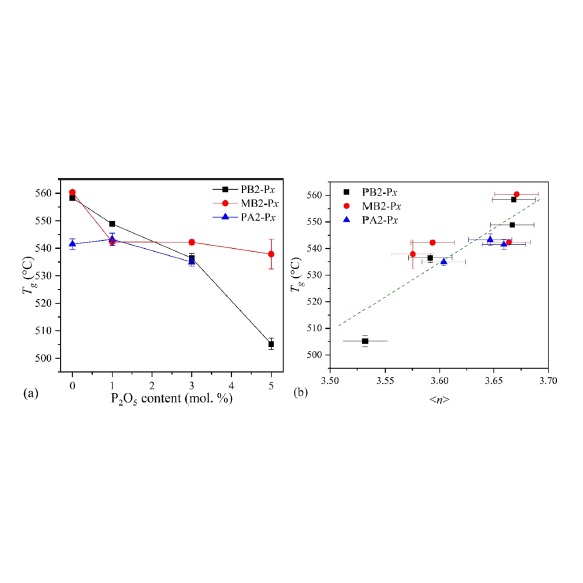Composition-structure-solubility relationships in borosilicate glasses: toward a rational design of bioactive glasses with controlled dissolution behavior.
STONE-WEISS, Nicholas; BRADTMÜLLER, Henrik; ECKERT, Hellmut; GOEL, Ashutosh.
STONE-WEISS, Nicholas; BRADTMÜLLER, Henrik; ECKERT, Hellmut; GOEL, Ashutosh.




 Abstract: Owing to their fast but tunable degradation kinetics (in comparison to silicates) and excellent bioactivity, the past decade has witnessed an upsurge in the research interest of borate/ borosilicate-based bioactive glasses for their potential use in a wide range of soft tissue regeneration applications. Nevertheless, most of these glasses have been developed using trial-and-error approaches wherein SiO2 has been gradually replaced by B2O3. One major reason for using this empirical approach is the complexity of shortto- intermediate range structures of these glasses which greatly complicate the development of a thorough understanding of composition-structure-solubility relationships in these systems. Transitioning beyond the current style of composition design to a style that facilitates the development of bioactive glasses with controlled ion release tailored for specific patients/diseases requires a deeper understanding of the compositional/structural dependence of glass degradation behavior in vitro and in vivo. Accordingly, the present study aims to decipher the structural drivers controlling the dissolution kinetics and ion-release behavior of potentially bioactive glasses designed in the Na2O-B2O3-P2O5-SiO2 system across a broad compositional space in simulated body environments (pH = 7.4). By employing state-of-the-art spectroscopybased characterization techniques, it has been shown that the degradation kinetics of borosilicate glasses depend on their R (Na2O/ B2O3) and K (SiO2/B2O3) ratios, while the release of particular network-forming moieties from the glass into solution is strongly influenced by their role in?and effect on?the short-to-intermediate-range molecular structure. The current study aims to promote a rational design of borosilicate-based bioactive glasses, where a delicate balance between maximizing soft tissue regeneration and minimizing calcification and cytotoxicity can be achieved by tuning the release of ionic dissolution products (of controlled identity and abundance) from bioactive glasses into physiological media.
Abstract: Owing to their fast but tunable degradation kinetics (in comparison to silicates) and excellent bioactivity, the past decade has witnessed an upsurge in the research interest of borate/ borosilicate-based bioactive glasses for their potential use in a wide range of soft tissue regeneration applications. Nevertheless, most of these glasses have been developed using trial-and-error approaches wherein SiO2 has been gradually replaced by B2O3. One major reason for using this empirical approach is the complexity of shortto- intermediate range structures of these glasses which greatly complicate the development of a thorough understanding of composition-structure-solubility relationships in these systems. Transitioning beyond the current style of composition design to a style that facilitates the development of bioactive glasses with controlled ion release tailored for specific patients/diseases requires a deeper understanding of the compositional/structural dependence of glass degradation behavior in vitro and in vivo. Accordingly, the present study aims to decipher the structural drivers controlling the dissolution kinetics and ion-release behavior of potentially bioactive glasses designed in the Na2O-B2O3-P2O5-SiO2 system across a broad compositional space in simulated body environments (pH = 7.4). By employing state-of-the-art spectroscopybased characterization techniques, it has been shown that the degradation kinetics of borosilicate glasses depend on their R (Na2O/ B2O3) and K (SiO2/B2O3) ratios, while the release of particular network-forming moieties from the glass into solution is strongly influenced by their role in?and effect on?the short-to-intermediate-range molecular structure. The current study aims to promote a rational design of borosilicate-based bioactive glasses, where a delicate balance between maximizing soft tissue regeneration and minimizing calcification and cytotoxicity can be achieved by tuning the release of ionic dissolution products (of controlled identity and abundance) from bioactive glasses into physiological media. @article={003037211,author = {STONE-WEISS, Nicholas; BRADTMÜLLER, Henrik; ECKERT, Hellmut; GOEL, Ashutosh.},title={Composition-structure-solubility relationships in borosilicate glasses: toward a rational design of bioactive glasses with controlled dissolution behavior},journal={ACS Applied Materials and Interfaces},note={v. 13, n. 27, p. 31495-31513},year={2021}}
@article={003037211,author = {STONE-WEISS, Nicholas; BRADTMÜLLER, Henrik; ECKERT, Hellmut; GOEL, Ashutosh.},title={Composition-structure-solubility relationships in borosilicate glasses: toward a rational design of bioactive glasses with controlled dissolution behavior},journal={ACS Applied Materials and Interfaces},note={v. 13, n. 27, p. 31495-31513},year={2021}}